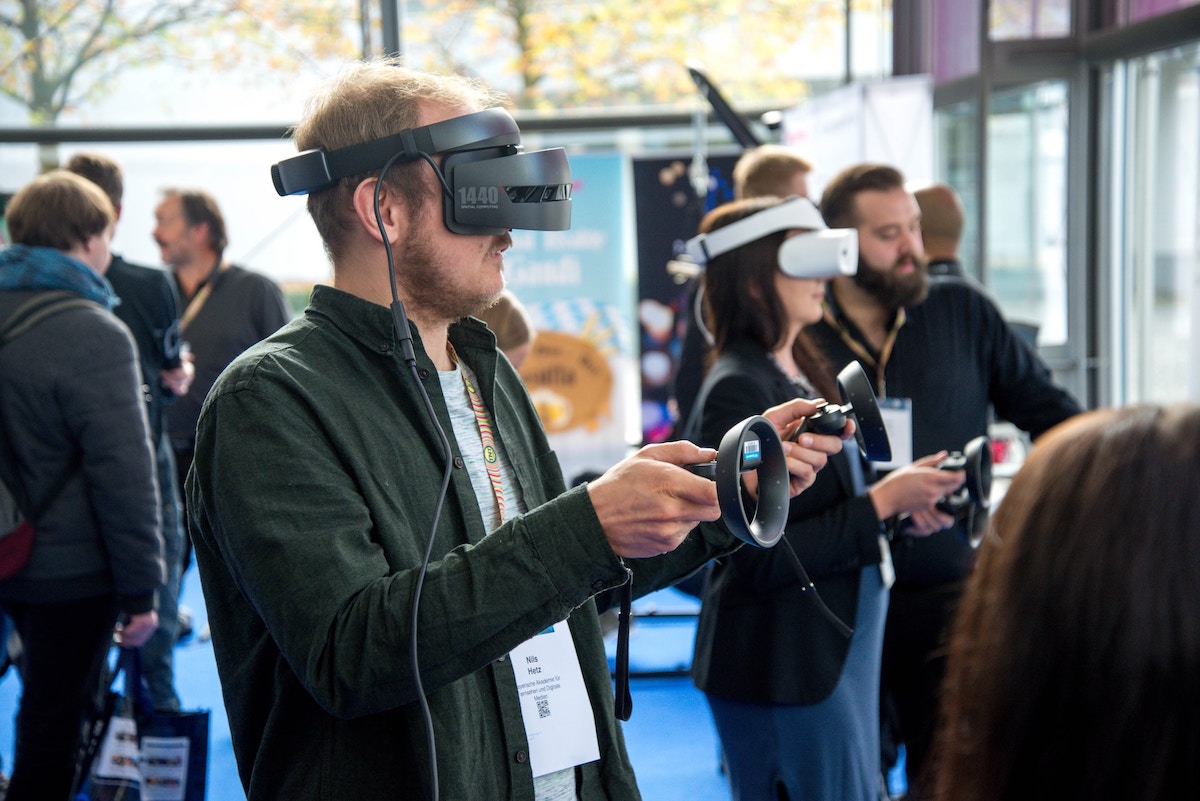Skift Take
Five technology companies showcased their innovative products at PCMA EduCon’s Tech Labs. But what did the planners think?
The virtual event wave of the pandemic may be behind us, but technology is still a hot topic in the industry. Nowhere was this clearer than at PCMA EduCon’s Tech Labs this year.
Each lab featured tech companies that are leading innovation for meetings and events. Were they sponsored sessions? PCMA made it clear they weren’t. Each session description ended with the statement: “No sponsors, no pay to play, no sales pitches, no pressure”
Anh Nguyen, principal and co-founder of Spark Event Collective, and Shawn Cheng, event strategist, conducted extensive research to hand pick the cream of the crop. Each lab was meant to include an experiential component, with participants given the opportunity to try the technology in “simulated event scenarios.” While a hands-on experience was more practical for some labs than others, they all allowed participants to see the technology in action. The floor was also open to unvetted questions from the audience, with some posing difficult questions — and others offering unsolicited testimonials.
1. Generative AI for Event Planners: Project Spark
If you attended EduCon, you know that the AI-themed sessions filled up first. Presented by tech company Gevme, the “AI & Events” tech labs offered an introduction to Project Spark, a generative AI interface designed to cater to the needs of event organizers and meeting planners.
Co-created with PCMA, the software is currently free for PCMA members to use. Workshop participants were even given temporary access without registering for login credentials. The left-hand menu included items like “Content”, “Repurpose,” and “Legal.” Under the content tab, event planners can choose from various formats used in their day-to-day work, such as marketing emails and session descriptions. Using the “repurpose” tab, planners can create spinoff content from video and audio recordings. Under the “legal” tab, getting feedback on contracts is an option. While some of the software’s functionality could be performed through ChatGPT, Spark makes creating content specifically for events much easier.
Discussion and Planner Reactions
Presenters Jonathon Easton, vice president of design for Gevme, and Veemal Gungadin, founder and CEO, emphasized that their software isn’t intended to replace jobs. Instead, they see it as a productivity tool for overstretched planners. But the biggest concern from participants wasn’t fear that their jobs would be stolen — it was privacy, particularly regarding contracts. According to Gungadin, privacy protections are one of the major advantages of using Spark over ChatGPT and other similar programs. The software can learn from the content you feed into it, but it only does so within your own account.
One participant said she already actively used the software to write content and analyze contracts. She noted that the feedback wasn’t on the level of a legal consultant, but it provided a sense of what was standard in the industry. As for the writing, it just made everything faster and easier.
Gungadin echoed the idea that the tool is an effective time saver rather than a perfect replacement for human talent: “It writes your first draft, not your final one.”
2. AI-Powered Facial Analysis for Events: Zenus
Analytical AI — which uses AI to process and derive insights from data rather than to create new content — had its own presence in the tech labs. In a workshop titled “Face-Off: The Good, the Bad, and the Ugly behind Facial Analysis at Events,” Zenus marketing director Nick Borelli tackled some of the tough questions around facial analysis, with Nguyen acting as moderator.
Zenus first attracted controversy following the usage of its facial analysis technology at PCMA Convening Leaders earlier this year. The tech works by capturing video images of audience members (or passersby in the case of installations) and analyzing how their facial expressions change over time. Much of the backlash following Convening Leaders centered around the notion of consent and invasions of privacy.
To fuel the fire, MWC Barcelona received a $219,000 (€200,000) fine for using facial recognition technology — which actually identifies individuals — in combination with passport scans. So were workshop participants outraged by the idea of facial analysis? Not quite.
Discussion and Planner Reactions
Unlike the other technologies shared via the tech labs, Zenus’ facial analysis doesn’t lend itself to hands-on use by workshop participants. Instead, they got to see the results of the facial analysis performed on them.
Borelli, who joined the conversation remotely, shared a screenshot of the graph that charted the audience’s excitement levels over the duration of his initial presentation — and then shared the results from other workshops held earlier during the event. While the results were not exactly the same, there was a clear pattern that mapped the emotional journey of the presentation.
The chart’s line dipped at the beginning, just when Borelli began discussing the erosion of privacy in online spaces. The line then lifted back up during discussions about the privacy measures Zenus has put in place to protect personally identifying information. (All video is deleted as it’s analyzed locally, and no personally-identifying information is recorded.)
This was not the only point where the discussion turned meta. “How many of you knew you were being recorded at EduCon?” Borelli asked. Only about 50 percent of participants were aware — and they had signed up for the Zenus workshop.
Most were unfazed by the technology once it was explained to them, but they agreed that they should be informed. Some were also skeptical about how meaningful the insights were. What if people were looking at their phones and reacting to something else, for example? Panos Moutafis, CEO and founder of Zenus explained that it’s a question of averages. With enough people, an accurate trend will emerge. If anything, the repeated pattern among the workshop charts showed just how predictable we all are.
Another participant asked why there wasn’t an option to opt out of the facial analysis. While this idea sounds fair in theory, it creates a catch 22. “In order to opt out, we’d have to recognize who you are,” explained Moutafis.
3. Holograms for Meetings and Events: ARHT Media
ARHT Media’s hologram capsules were front and center on the main floor of PCMA Educon, right near the PCMA information desk. It was the workshop participants, however, who had the opportunity to see themselves transformed into a hologram. On one side of the stage was a capsule, and on the other a recording studio.
The capsule is a large rectangular screen that creates the illusion of a 3D figure on a white backdrop. It’s also possible to add 3D graphics. As a touch screen, it also presents the option for interactive components.
ARHT Media has two other core products as well: mesh holograms, which have the effect of “floating” in space, and virtual event technology, which captures and shares full-body live streams of presenters (from anywhere in the world) set against a virtual backdrop. While workshop participants didn’t have the chance to try these other tools firsthand, they saw them presented on screen.
Discussion and Planner Reactions
ARHT Media first demonstrated its capsule technology by beaming in a staff member from their Toronto headquarters. He responded to participant questions in real time — including one about the color of one woman’s shirt (which he answered correctly).
Andrew Dorcas, senior vice president of ARHT Media, explained that this interactivity can catch people by surprise. Passersby are often at first startled and then amused when a capsule hologram begins talking back to them at event installations. Some of the workshop participants had fun pretending they were trapped inside the box.
Apart from allowing marketing reps to beam onto the show floor and speakers to teleport onto stages, the holograms have also been used to display audience members asking questions.
“Does this feel like Star Trek to you sometimes?” asked one participant. As it so happens, ARHT’s mesh holograms took center stage at a Star Trek promo event, with the show’s stars beaming into London’s MCM Comic Con from New York and LA.
4. Interactive Smart Badges: Badgee
Event badges may not be the first thing that comes to mind when thinking of innovative technology, but Captag’s new Badgee product is hoping to change that. The product recently won the Launchpad Competition at Event Tech Live.
The electronic smart badges are rechargeable and can be paired with an event app to manage registration and a variety of add-ons. Specific features include polling (with the screen image automatically matching the wearer’s view when lifted), gamification, and networking tools. For example, tapping badges together enables the exchange of contact information, and colored lights on the device can act as a signal for topics of personal interest.
Discussion and Planner Reactions
Workshop participants particularly enjoyed the opportunity to strike up a conversation based on the topic indicated by the color of their badge light.
If there was any criticism of the product, it was on the company’s business model. One participant expressed frustration that the badges could not be purchased outright but instead had to be rented.
5. AR and VR: Encore and West Peek Productions
Two years ago, virtual reality might have had almost as much hype around it as AI does now. While the backlash against it has been almost as swift as the initial buzz, both VR and AR experiences continue to impact the event industry.
Christopher Baron, senior director of digital services for Encore, led participants in interactive AR experiences with various event applications, from 3D visualizations to real-time data overlays.
For West Peek Productions’ tech lab on “metaverse” experiences, participants could wear Oculus headsets and explore a VR replica of Morehouse College. Scooter Taylor, West Peek Productions’ co-founder, explained that the college’s digital twin was initially created for a fundraising gala with the idea of allowing more students to experience the once-exclusive event.
Discussion and Planner Reactions
While many participants were excited by the idea of virtual reality, several wanted to know why the graphics aren’t better. Taylor explained that VR graphics are often simplified because they require more processing power than equivalent 2D images. At the same time, the headset hardware has lower processing power than typical gaming consoles.
Pushing the matter further, participants wanted to know whether we can expect realistic VR experiences anytime soon. Taylor was optimistic that Apple’s upcoming release of its new mixed reality headset would help to kickstart the next generation of VR tech. As inspiration for what’s already possible, he also shared video recordings of the NBA’s VR app, which uses five 8K cameras and advanced AI processing to simulate the courtside experience (including the ability to sub in avatars for players).
Can we tour a city with real-time video footage of people on the street? Taylor said consent might be an issue, but theoretically, it’s possible.
Despite having expressed a desire for more realism earlier, participants were impressed when they donned the headsets and experienced what it was like to move through digital space.
The science fiction fantasies of years past are quickly becoming a reality, and event technology is keeping pace. If EduCon’s tech labs are any indications, many event planners are ready to try it — even if they come to the table with more questions than nods of approval.
Photo credit: stephan sorkin / Unsplash





